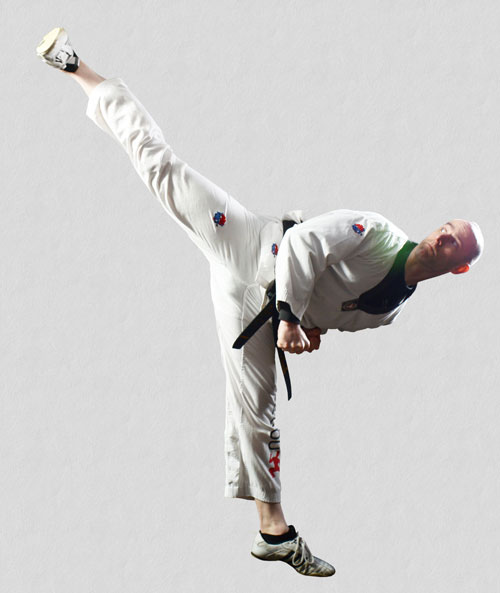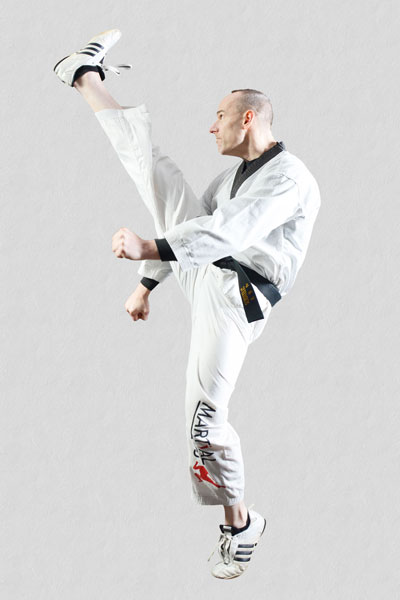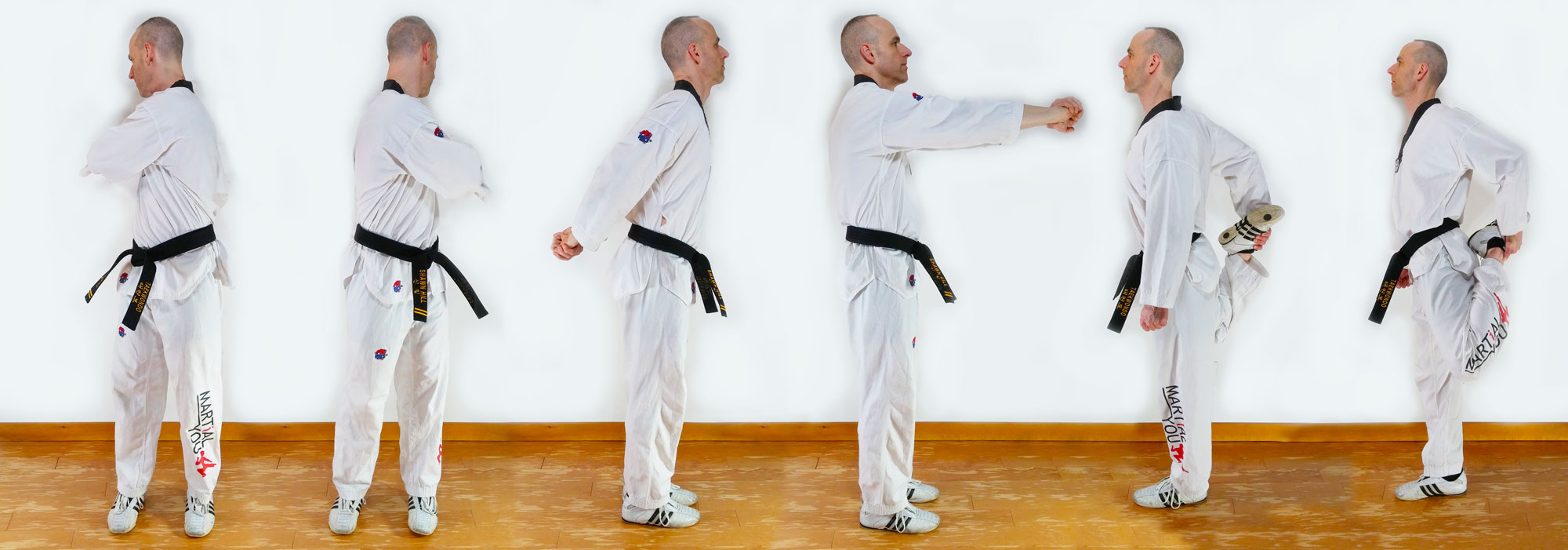 Stretching is essential for most of us to achieve the range of motion required for those high kicks and wide stances learned through martial arts. There are plenty of movements that would benefit from well stretched flexible muscle groups both in the upper and lower sections of our bodies. In Taekwondo, as well as other arts, we maneuver our bodies through high and low stances while twisting our trunk left and right. We extend our arms to block and throw punches and our legs to kick. Many of these movements require a great range of motion in the joints directly related to the mechanics involved. Some percentage of folks, especially those of the female gender, are lucky and have a natural amount of flexibility, allowing them to achieve greater range of motion with less need to stretch. But, if you’re like me and not part of that flexible percentile, you need to stretch!
Stretching is essential for most of us to achieve the range of motion required for those high kicks and wide stances learned through martial arts. There are plenty of movements that would benefit from well stretched flexible muscle groups both in the upper and lower sections of our bodies. In Taekwondo, as well as other arts, we maneuver our bodies through high and low stances while twisting our trunk left and right. We extend our arms to block and throw punches and our legs to kick. Many of these movements require a great range of motion in the joints directly related to the mechanics involved. Some percentage of folks, especially those of the female gender, are lucky and have a natural amount of flexibility, allowing them to achieve greater range of motion with less need to stretch. But, if you’re like me and not part of that flexible percentile, you need to stretch!
But why? Well, one very good theory based on something called the “stretch reflex” or “myotatic reflex,” is that our nervous system has a wonderful protective mechanism built in, and it has made the decision, on our behalf, based on our day to day activities and physical experiences, to pick the “safe” length of each muscle and it pretty much likes to keep everything just how it is. If all your life you’ve never needed to stretch your legs out into a split then why should your nervous system take the risk of letting muscles lengthen enough to do a split when you turn 30 and suddenly decide you want to kick to the ceiling. It doesn’t want to because it may not be safe, and it’s for our own good. We basically need to work with our nervous system, and retrain it, so that it knows doing a split is safe. Only then will our own body allow us to do what we want. How about that?
There are three types of stretching that I personally recommend someone rotate through or combine in order to become more flexible for martial arts, static stretching, dynamic stretching, and PNF Stretching also known as proprioceptive neuromuscular facilitation. We’ll keep that third one named PNF stretching from here on out. I DO NOT recommend the fourth method called ballistic stretching as it may result in injury when improperly done.
 Dynamic stretches are great when you slowly introduce them during a warmup routine and used them to lead into training. They’re done by performing slow controlled movements through a full range of motion. Full arm rotations or slow leg raises front to back would be an example of dynamic stretching. Static stretches are awesome, but I recommend using them at the end of training because holding those positions tends to cool you down and many will experience muscle tightening as a result which is not good if you’re going to start kicking drills right after stretching.
Dynamic stretches are great when you slowly introduce them during a warmup routine and used them to lead into training. They’re done by performing slow controlled movements through a full range of motion. Full arm rotations or slow leg raises front to back would be an example of dynamic stretching. Static stretches are awesome, but I recommend using them at the end of training because holding those positions tends to cool you down and many will experience muscle tightening as a result which is not good if you’re going to start kicking drills right after stretching.
The PNF method of stretching is also great after training and you are ready to begin the cool down. The muscles are in prime condition for either static or PNF type stretching. In general static stretches seem to be the most widely used and most popular among many martial arts studios but I tend to add a little PNF stretching in the mix. Placing yourself in a stretching position and at first resisting the stretch on purpose for 15-20 seconds before relaxing and allowing the muscles to lengthen makes use of passive PNF stretching. If you want to make use of active PNF stretching you can first contract the muscle opposing the muscle you’re trying to stretch for 10-15 seconds, switch to contracting the muscle you’re stretching (resisting the stretch) for 15-20 seconds, and finally, relax all the muscles to fall into a static stretch for another 30 seconds.
SOME BASIC STRETCHES FOR FLEXIBILITY
Here are some popular basic stretches for achieving a good overall flexibility for taekwondo training. Begin with the upper body stretches because they are nice to start with and can ease you into lower body stretches in a natural progression as you go.




Work through the lower body and stretch all the muscle groups needed to achieve those wide stances and high kicks. Make sure you ease into each stretch and stop if you feel joint pain rather than muscle tension. Begin the stretches with slight tension and breathe slowly exhaling as you increase the stretch. It’s extremely important to breathe calmly and relax your body and mind because your nervous system responds to stresses by tightening your muscles. The more relaxed you are and the more you assure your nervous system everything is okay, the getter your gains with be.

Butterfly stretch seen to the upper left is especially good when done PNF style. Hold your ankles while using the elbows to press downward on your knees while at the same time resist the downward force by trying to bring the knees up and closer together. After about 15 seconds slowly relax and let the downward force of your elbows press the knees further apart.

Straddle split shown on the upper right is another good stretch used to help gain height in side kicks, hook kicks, spinning hook kicks and pretty much any kick requiring you to kick high while turned sideways. A common issue people have with this stretch is the feeling of pain while doing it. Typically this is because it’s done improperly and the joints are being stressed along with connective tissue rather than muscle being stretched. Start by placing your hands behind your body and on the floor behind you. Straighten your posture while seated and roll your hip forward while pointing the toes up to the ceiling. Slowly increase this stretch without feeling joint pain until you can reach in front of your body.

Front splits, shown on the upper left, are extremely important stretches for all kicking techniques. Having a good range of motion in this direction affects just about every kick in the taekwondo toolbox. I recommend everyone really work often to increase flexibility in this direction. If you are kicking and feel your non kicking leg being pulled out from under you, chances are you need to add more front split stretch time. This is another stretch that is easy to apply PNF to. In fact you may do it without realizing as much. Simply resist allowing the legs to move apart for about 15 seconds and then slowly relax and let your body weight move them further away.
If you’re unable to reach the floor at first, do the stretch in between to chairs with the seats facing you. Place your hands on the chairs seat and hold yourself in place that way. Work your way down and eventually you will not need the chairs anymore.

